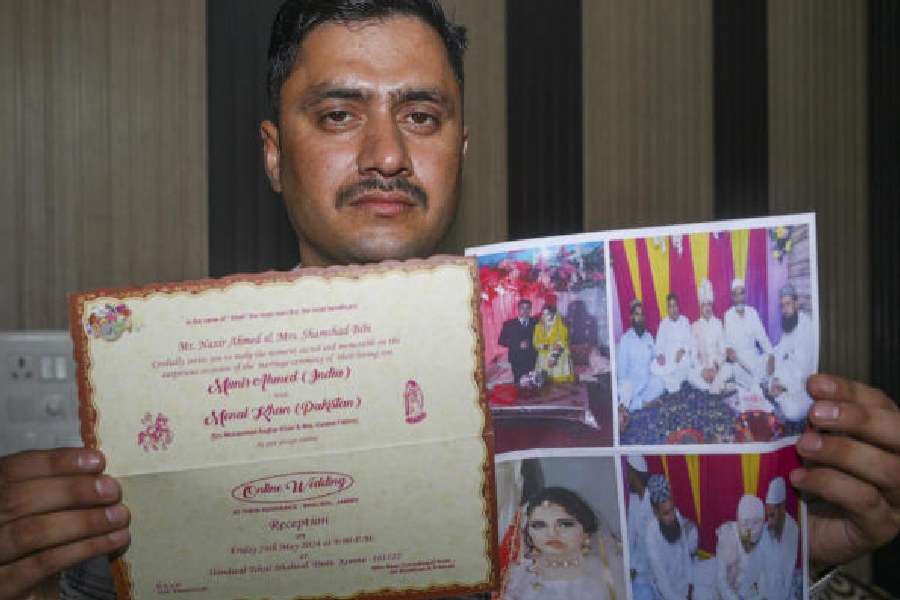 |
James Bond might have faced an unusual moment of doubt and uncertainty. What would the intrepid British secret agent have done if quizzed by the bartender: “May I serve you Martini made with 42Below premium vodka from New Zealand? Or would you like the quadruple distilled Chopin from Poland, or the Irish Boru or Ketel One from Holland? Figure it out Mr Secret Agent.”
Bond never had such moments but every young Indian barfly regularly faces such mind-numbing dilemmas when he gazes at the ever-increasing row of super-premium vodka bottles twinkling at him from above the bar.
Should he try the Wyborowa which wins the sexy bottle stakes — designed by the world’s most revered architect Frank Gehry? Or should he/she settle for the gold edition of the super-premium Kauffman vodka? Kauffman is a highflyer in the choicest bottle stakes because it looks like it should contain perfume and not vodka and has a gold-plated cap. Oh, one word of warning: don’t forget to take along your solid gold credit card because Kauffman retails for around Rs 50,000 a bottle at the Taj Hotel bar in Delhi.
If you’re feeling a bit short of the readies, perhaps you could slum it with the regular or silver edition of Kauffman which will come sliding over the bar for a mere Rs 1,300 a peg. The gold version comes for about Rs 13,000 a 60ml peg at the Taj. And don’t think for a moment that Indians are discouraged by the sky-high prices. “We have almost polished off a bottle in the last one month as people are curious about this brand,” says R.M Praveen, manager at Rick’s Bar in the Taj Mansingh, Delhi.
The fact is that around the world the younger generation is knocking back the white spirit in industrial quantities — and India is no exception. And liquor companies are serving up what the youngsters are asking for on their nights out.
Liquid luxury
 |
Take a look at the giant Moët-Hennessy which has launched Belvedere Intense ($65 for a 750ml bottle). Intense is an even more upmarket version of its popular Belvedere vodka. “It is full-bodied and double-filtered through charcoal,” says Gaurav Bhatia, head of marketing for the brand at LVMH.
“India is turning into a white spirit market. Cheap vodka is definitely out and people want nothing but the best,” adds Bhatia. LVMH will launch a new front in the vodka wars with another ultra-luxury brand next year.
The world’s largest spirits company Diageo is also determined to stay ahead in the vodka pouring game. Its Cîroc, which comes in several flavours, is already a top-seller and Diageo India chief, Asif Adil, says the company will soon launch Ketel One, a Dutch premium vodka that has made a splash in markets abroad. “This will enable us to offer our consumers another super-premium choice,” says Adil.
One bar that has pinned its colours to the vodka revolution is Aura, the vodka bar at The Claridges in Delhi. Aura lives up to its name by offering premium vodkas from around the world and bar captain Manjeet Singh takes delight in guiding his guests through the exhaustive menu.
From Russia alone there are 16 premium varieties at Aura. The most popular is the ultra-premium Jewel of Russia Classic (Rs 450 per 30 ml) said to have been made by undergoing a slow five-stage filtration process through specially-modified charcoal made from the stones of peaches and apricots.
Since packaging is key in the vodka game, Jewel of Russia labels are hand-painted and signed by the individual artist. If that doesn’t catch your fancy how about Rusky Standard, filtered through quartz crystal filters?
From Poland, there are 18 brands at Aura with Krolewska (Rs 450 for 30ml) topping the list. This is produced from deluxe grain alcohol produced in Poland’s ‘ecologically cleanest’ areas.
Higher up the scale is Jean Marc XO (Rs 700 for 30 ml at Aura) made in France. Its proud boast is that it’s made using ‘spring water filtered through Grande Champagne limestone and distilled nine times in small batches using traditional copper alembic stills’.
Making it work
 |
The fact of the matter is that making vodka is almost ridiculously easy and inexpensive. There’s none of the ritual and pomp — the distilling and storing in rosewood casks in the heart of Scotland — that’s needed for a top quality single malt. Vodka is made from a range of products including barley, rye, wheat or molasses which are distilled in a still and then filtered through charcoal.
Today the fancier brands promise they’ve been double-distilled, triple-distilled (Blackwood Diva) or distilled multiple times. But the fact is that you can bottle and sell it fairly quickly without too much fuss.
Double Cross, one of the few Slovak vodkas, promises that it has been filtered through diamond dust. The bottles also come with Slovak poetry on them. Similarly Cîroc, made from grape, is distilled five times. Says Diageo’s Adil: “Cîroc is distilled five times to produce exquisitely smooth vodka with a uniquely crisp, clean, smooth taste experience.”
Rising stars
 |
| Bartenders prefer premium vodkas as they make for a better base for many trendy cocktails |
As vodka’s so easy to make, there has been a flood of new brands — even real estate tycoon Donald Trump launched his own vodka earlier this year. They all come with extravagant and almost astonishing claims. Consider Stolichnaya Gold which promises that: “Even in deep sleep you can discern the vodka’s heritage.” And Belvedere goes way back to the Middle Ages when it proudly offers that: “Following traditions dating back over 600 years, Belvedere is handcrafted in small batches.”
The marketing hype is matched by the most extravagantly beautiful and over-designed bottles that the liquor trade has ever dreamt up.
So vodka, once the liquid that helped Russian peasants through the winter, has gone global. It’s even made in places like Ireland (Boru) and New Zealand (42Below, which gets its name from the fact that it’s made around the 42nd Parallel).
Innovation
 |
The buzz around vodka and its demand has resulted in some innovative offerings for those who want to experiment. Aura, the vodka bar, for instance offers its special vodka platters for the brave hearted.
The Premium Platter (Rs 1,500) consists of three vodka shots — one Grey Goose followed by one Polska Gold and Wyborowa. If you like your poison with a slightly different tang, try the Flavoured Vodka Platter — a chilled shot of Stoli orange, followed up with an Absolut Kurant and a Finlandia lime. Or try the Russian or the Polish platters, which offer vodkas from those countries.
Martini magic
Have barmen switched drinks? The answer is yes. Many top barmen now prefer to use vodka for martinis. “Vodka is the most silent spirit besides being versatile. It’s odourless and colourless, and that’s why it’s the best base for any cocktail. It doesn’t overpower the flavour unlike gin,” says bartender Yangdup Lama.
Manjeet Singh of Aura agrees. At his bar, Singh offers a range of 10 Martinis and he usually uses premium vodkas like Belvedere, 42Below or Cîroc.
He reckons the bar has sales of upto 1,900 Martinis per month out of which 90 per cent are vodka-based. In Tabula Rasa, a Delhi bar, one of the specials is the Dirty Martini made with top quality vodka. “It’s essentially to enhance the taste that will be finer and smoother,” says Tabula Rasa owner Sohrab Sitaram.
Flavoured vodkas
Flavoured vodkas were originally produced to mask the flavour of the first primitive vodkas. Now, youngsters seem to like the fruity tastes so most spirit companies are working overtime to pour out a range of new flavours. Take Skyy vodka’s range of flavoured spirit for instance. The Californian-origin vodka offers several flavours including vanilla, citrus, orange and berry. The range was launched in India two years ago and Sumit Saxena, brand manager, Focus Brands that represents luxury premium spirits including Skyy in India, says there’s more. “We are coming up with a new format of flavoured vodka where the flavours will be added during the process of distillation,” he says.
Even local companies have figured they can distil profits from vodka. Three years ago Radico Khaitan rolled out Magic Moments, a semi-premium gin and vodka. They quickly discovered that vodka was outselling gin by a big margin. Now it has launched a slightly more premium (triple-distilled) version of Magic Moments to come in six flav-ours — lemon, orange, raspberry, lemon grass with ginger, chocolate and green apple. “We figured that consumers would like to try new flavours,” says Raju Vaziraney, COO, Radico Khaitan.
All the bartenders agree that premium vodka, whether it’s triple or quadruple distilled, through diamond dust or some other equally fancy product, is better than the cheaper stuff. The younger generation’s also buying the argument and drinking a toast to the vodka revolution.
Finding flavour
 |
Once upon a time vodka was the favourite tipple of Russian peasants. If the truth be told it was rotgut and you needed to hold your breath while gulping it down. Today vodka comes in a range of exotic flavours. Here are a few:
Kubanskaya Vodka flavoured with an infusion of dried lemon and orange peels.
Limonnaya Lemon-flavoured vodka, with a hint of sugar.
Okhotnichya A most unusual vodka flavour with ginger, cloves, lemon peel, coffee, anise and other herbs and spices. It’s then blended with sugar and a dash of wine (similar to white port).
Pertsovka Pepper-flavoured vodka, prepared with black peppercorns and red chili peppers.
Starka Old vodka, a holdover from the early centuries of vodka production, which can be infused with everything from fruit tree leaves to brandy, port, Malaga wine and dried fruit. Some brands are aged in oak casks.
Zubrovka – Zubrowka (a Polish term) Vodka flavored with buffalo — or rather, bison — grass, which is an aromatic grass favoured by the herds of the rare European bison.










